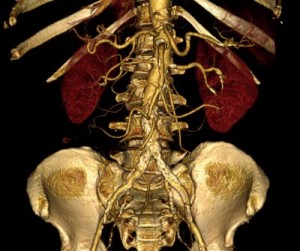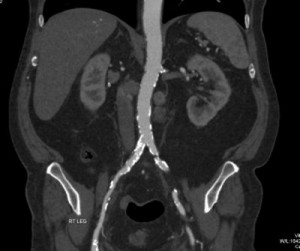- What is this investigation?
- How do I prepare for the CTA?
- What does this investigation involve?
- What happens after the CTA?
- Are there any risks?
What is this investigation?
Generally speaking, angiography is an imaging investigation to take pictures of your blood vessels.
Computerized tomographic angiography (CTA) is done at the computerized tomography suite, and uses x-rays after previous injection of a liquid, the “contrast”, into a vein in your arm. The contrast, makes the blood flowing inside the blood vessels visible on an x-ray. The contrast is later eliminated from your body through your kidneys and your urine. This investigation is essentially pain-free, and takes only a few minutes with the modern tomographic scanners.
Physicians use CTA to study narrow, blocked, enlarged or abnormal arteries or veins in various parts of the body, including the brain, the chest, the heart chest, the abdomen and the limbs.
How do I prepare for the CTA?
No admission is required for this investigation. The clinician who has requested the investigation will have ususally arranged for certain laboratory tests, such as checking kidney function, to be performed prior to the CTA.
You will be asked to be starved for 1-2 hours before the investigation and, occasionally, intravenous fluids may be administered to you to prevent deterioration of your kidney function. You may be asked to have discontinued certain medications like Glucophage (an antidiabetic drug) a couple of days before the test. If you are allergic to the contrast material or iodine, you may be preventively given some medication to reduce the risk of an allergic reaction.
What does this investigation involve?
CTA is done at the site of the computerized tomography suite.
Initially, the contrast will be administered in a vein in your arm. During the test, the technician may ask you to hold your breath for about 5 to 15 seconds. In addition, they may ask you to lie perfectly still to prevent sudden movements from blurring the x-ray pictures. The body of the CT scanner moves automatically to take a series of pictures, which the specialized radiologist will process and reconstruct later on to study the vessels of interest.
The whole investigation will take less than 30 minutes.


CT Angiogram of the abdominal aorta and the iliac arteries: Heavy arterial calcifications at the level of the aortic bifurcation and significant narrowing (>80%) of the origin of the right common iliac artery.
What happens after the CTA?
You should be allowed to leave the medical center soon after the investigation is completed, and return to your normal activities. Keep drinking plenty of fluids for the rest of the day.
Are there any risks?
Practically no problems are expected if the function of your kidneys is normal and appropriate preventive measures have been taken in case you are allergic.
– The contrast agent may (usually temporarily) reduce your kidney function especially if it was already impaired.
– Rarely, allergic reactions can occur, especially among people who have had previous allergic reactions to the contrast. Severe reactions occur with a frequency of 1 in 3000.
– Infrequently, if you suffer from asthma/ chronic bronchitis, angina pectoris or a heart condition associated with poor pumping action, such as congestive heart failure, you may experience shortness of breath or fluid overload. This may very rarely be a significant problem.
Last modified 11/11/2014






